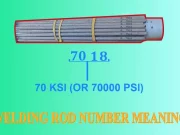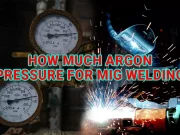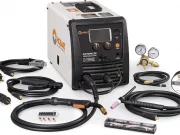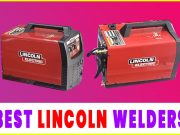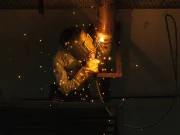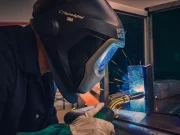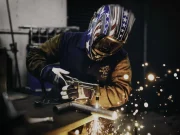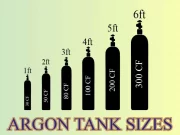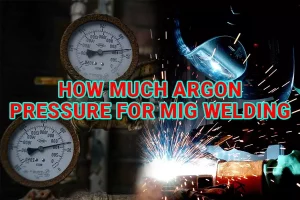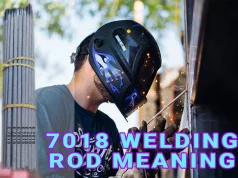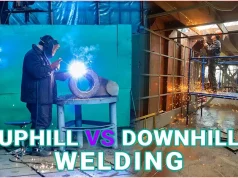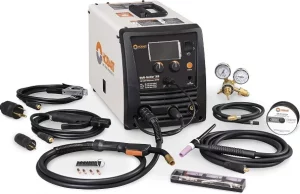In the past, welding did not need gases; the introduction of TIG and MIG welding machines led to their usage.
People love MIG welding since it produces neater and cleaner welds, plus it offers continuous welding.
The process should have a continuous wire for an amazing weld. Unlike other welding methods, you will not need filler materials in MIG welding.
However, MIG welding needs gas, and it’s quite important to know the MIG welding pressure and flow.
It’s because the quality of your welds depends on this factor. The MIG welding pressure depends on the settings, regulator pressure, and gas type. So, let’s find out.
How Much Is Argon Pressure for MIG Welding
The MIG welding has a line system that can take 50 psi as minimum pressure. Argon flow rate affects the pressure, and it can fluctuate up to 15-30 psi.
You should maintain MIG welding argon pressure between 14-16 psi for great results. However, do not let the pressure go above 25 psi.
Additional Information
The Gas Pressure To Use In Welding
You need to adjust the gas flow depending on the welder’s nozzle inside diameter. Each diameter has a different typical, maximum and minimum flow rate. The measurement for gas flow is CFH.
PSI is the measurement for pressure. CFH is the initial for cubic feet per hour and is the gas amount that will pass through the nozzle.
It’s essential to maintain the correct CFH to get a smooth weld. An insufficient weld pool will have your weld infected by outside chemicals such as unwanted gasses and particulate matter in the air.
Nozzle Size
The minimum gas flow of a ½ inch nozzle should be approximately 18 CFH. The flow is around 18-22 CFH – however, it depends on the welding environment conditions.
In the welding process, ensure you don’t surpass 40 CFH. Almost all small welding machines owned by hobbyists and private individuals have ½ inch nozzles.
The minimum gas flow for 5/8 nozzles is usually about 22 CFH, although this type of nozzles typically has 30-35 CFH. Most industrial welding machines do have this nozzle diameter.
There’s also the ¾ inch nozzle common when using large core wire. You need to have 30 CFH as your minimum gas flow with this nozzle.
However, most welders usually use between 30-40 CFH, and as a welder, you shouldn’t go beyond 65 CFH.
Purpose Of The Welding Gas
There are different welding gasses, and they are for different purposes. The main purpose of welding gas is to protect the arch from impurities like other gases and dust.
Welding gas also heats the metals and ensures the weld is clean. Reactive and inert gas are the two popular welding gases categories.
Inert gases are distinctive and don’t change when in contact with temperatures and other substances.
The gas usually possesses the same form throughout the welding process. Therefore inert gases are ideal if you don’t want distortion or weakening of the weld.
Reactive gases are simply the opposite – they do react depending on the environment or circumstance they’re in.
Reactive gases can change themselves or create change. Therefore they are great because metals fusion is through positive changes.
Shielding Gas
As mentioned, shielding is the main purpose of welding gas. During welding, air can get into the middle of the welding arc and result in molten metal bubbles.
The bubbles can weaken the weld or ruin its appearance. MIG welding without shielding gas is impossible. Alternatively, you can use flux-coated or cored filler metal.
It does the same work of keeping impurities out of the weld but differently. Most welders use inert gases for shielding –their inert properties keep them stable during extreme pressure and heat welding.
Each gas has its different capabilities and positives; some offer more fluidity or penetration.
Popular Welding Gases
Argon
It ranks under inert gases, which means it doesn’t react with other substances. Of all inert gases, argon is the most abundant on earth.
It’s commonly used as a shielding gas to prevent air from entering the welding arc. Argon is also commonly used in primary welding stages and purging.
Carbon Dioxide
It’s popularly known as CO2 and is quite abundant on earth. Carbon dioxide is common in plasma shielding and MIG welding.
The gas is from organic matter and thus not expensive, but its quality isn’t similar to argon. Still, you can use carbon dioxide without adding other gases. Overall people prefer it since it’s cheaper and widely available.
Oxygen
Oxygen is among the most reactive gases globally and is passive and friendly. Welders usually mix oxygen with small amounts of shielding gases.
Oxygen adds fluidity to the molten weld, thus fastening the process. During gas welding, it increases heat and is popular in metal cutting through a process known as oxy-cutting.
If you mix oxygen with acetylene, you’ll get high-temperature flames that perfectly weld metals.
In welding, you add small oxygen to inert gasses for pressure stabilization. Putting oxygen in the mixture prevents coarse metal joints and stainless steel penetration.
Nitrogen
It’s the most abundant atmospheric gas and is crucial for all living organisms. Nitrogen works perfectly as a shielding gas after mixing it with other shielding gases.
You can also utilize it for several other specific applications. Nitrogen stabilizes the arc, deepens penetration, and increases the alloy’s mechanical properties.
Hydrogen
It’s among the most abundant gases on earth and burns without emissions. It’s also popularly in shielding with other shielding gases.
However, you should only add a small amount for safety purposes. Hydrogen makes cleaner welds than other gases and also increases penetration.
Helium
Welders do not use this gas directly in MIG welding; they add to argon.
The main purpose of helium in welding is to increase argon’s fluidity. You can only mix helium and argon in all welding types.
Why Do Welders Use Argon?
The role of argon is a shielding agent, and it protects welders from high temperatures. High temperatures are good too when working with metals, and you can melt the metals and mold them into anything tool or thing you want.
This high temperature melts most metals and makes it easy to weld and shape them appropriately.
Argon shields the melting metal. Metals react against some gases in their air when they meet high temperatures.
Some gases that react with hot temperatures are oxygen, hydrogen, and nitrogen, and the outcomes can be undesirable.
Therefore the argon gas is applied to metals to prevent them from reacting with other air components.
In addition to being a good air shielding agent, it can also help maintain the stability of the arc. When it comes to metals, better appearance, and good weld penetration is appreciated.
The Dangers Of Argon Gas
If you are using any gas, you need to be keen and take necessary precautions – ensure the gas is safe to use.
Overall, argon is usually safe to use, it’s usually nonflammable and nontoxic, and it’s the reason why many welders prefer using it.
Therefore it means that the gas won’t burn if you expose it to sparks, flame, or heat. However, you still need to be cautious when using argon gas.
The argon gas comes in compressed tanks, with its precautions. As a welder, you should follow the safety measures on the tank when using the product.
Argon can be quite dangerous when it’s too much in the person’s environment using it. Air is 38% less dense than argon; therefore, a higher amount of argon in the air can make breathing difficult.
It’s advisable to use argon outdoors or in places with great ventilation. There are limits on the amount of argon you can store in a tank. Tanks always have enough safe hydrogen amounts and won’t be excess in the atmosphere.
How Long Can An Argon Tank Last?
The argon gas is important to a welder and most regularly uses the gas. The amount of time an argon tank lasts depends on the tank usage composition and usage.
The main thing that determines the period it lasts is the tank size. The tanks come in different sizes, and if you choose a larger one, it will push for some time. Tanks pressure setting can also affect how long it lasts.
Please make sure the pre and post-flow settings are okay since they determine how long the argon tank will last.
The most common tank that welders receive is usually 30 to 40 SCF. If you regularly use this tank, it will last approximately three to six months.
Conclusion
Knowing the MIG welding will make you more comfortable. There are several gases in welding, but most people choose a gas depending on its availability and cost.
You can set the regulator for better gas usage and make sure you have basic information about welding gasses.
You May Like These Articles As Well:




